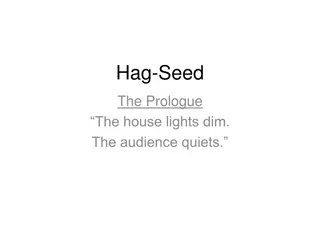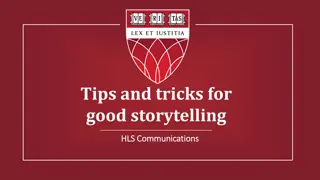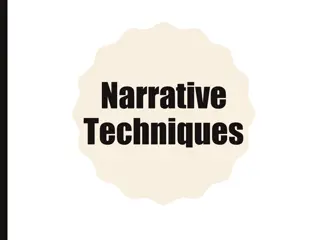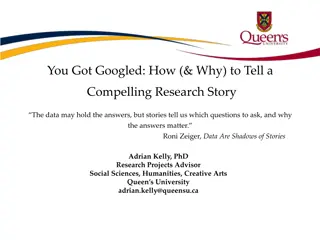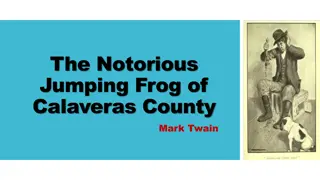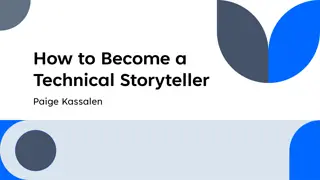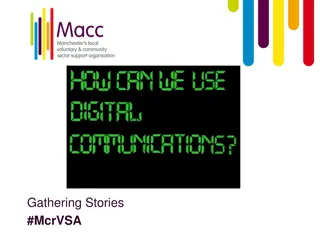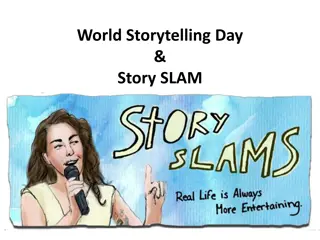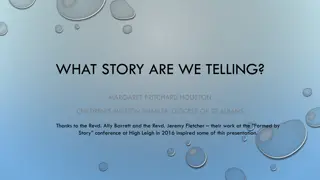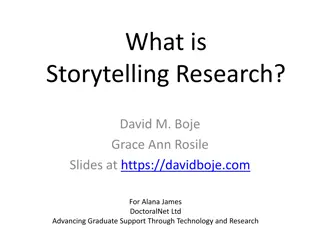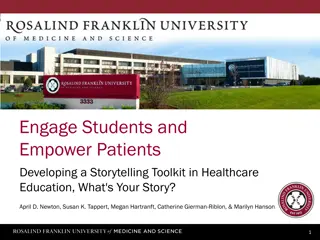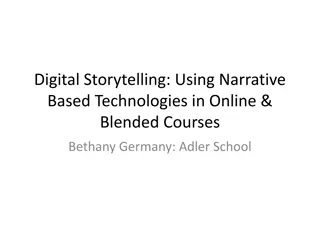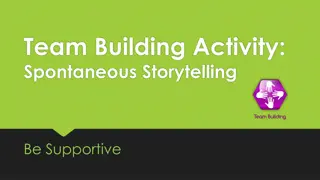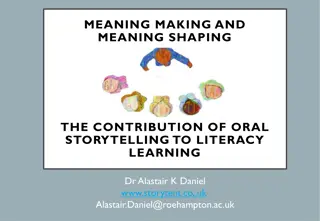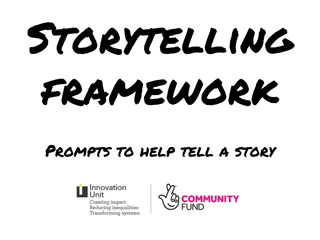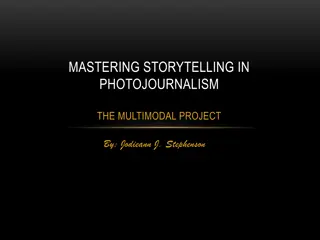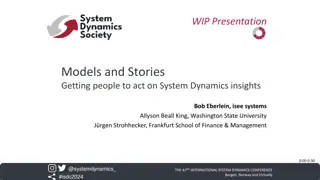Enhancing Education Through the Power of Storytelling
Utilizing storytelling in educational environments fosters meaningful connections between educators and students, leveraging humans' inherent inclination to engage with narratives. By tracing the historical significance of oral traditions to modern-day communication strategies, the impact of storytelling on learning becomes evident, transcending cultural boundaries and resonating with audiences of all ages.
Download Presentation

Please find below an Image/Link to download the presentation.
The content on the website is provided AS IS for your information and personal use only. It may not be sold, licensed, or shared on other websites without obtaining consent from the author.If you encounter any issues during the download, it is possible that the publisher has removed the file from their server.
You are allowed to download the files provided on this website for personal or commercial use, subject to the condition that they are used lawfully. All files are the property of their respective owners.
The content on the website is provided AS IS for your information and personal use only. It may not be sold, licensed, or shared on other websites without obtaining consent from the author.
E N D
Presentation Transcript
Centre for International English In-sessional English Support Paragraph Structure
Paragraph definition A paragraph is a group of sentences that develop one topic or idea. The topic of one paragraph should follow logically from the topic of the last paragraph and should lead on to the topic of the next paragraph. Paragraphs have different functions, but all develop an idea - that is, they add information, explanation, examples and illustrations to the central theme or idea until the theme is fully developed.
PEAL PEAL P Point (Topic Sentence) E Evidence (Support sentences) A Analysis (Explanation) L Link (to the next paragraph and the essay title)
Topic sentence A sentence that usually expresses the main idea of each paragraph. This sentence is usually found at the beginning of the paragraph (but can come at the end or even in the middle of the paragraph).
What is the topic of this paragraph? Using storytelling in educational settings can enable educators to connect with their students because of inborn tendencies for humans to listen to stories. Written languages have only existed for between 6,000 and 7,000 years (Daniels and Bright, 1995). Before then, and continually ever since in many cultures, important lessons for life were passed on using the oral tradition of storytelling. These varied from simple informative tales, to help us learn how to find food or avoid danger, to more magical and miraculous stories designed to help us see how we can resolve conflict and find our place in society (Zipes, 2012). Oral storytelling traditions are still fundamental to native American culture and Rebecca Bishop, a native American public relations officer (quoted in Sorensen, 2012) believes that the physical act of storytelling is a special thing; children will automatically stop what they are doing and listen when a story is told. Professional communicators report that this continues to adulthood (Simmons, 2006; Stevenson, 2008). This means that storytelling can be a powerful tool for connecting with students of all ages in a way that a list of bullet points in a PowerPoint presentation cannot. The emotional connection and innate, almost hardwired, need to listen when someone tells a story means that educators can teach memorable lessons in a uniquely engaging manner that is common to all cultures.
Evidence Evidence The evidence is usually paraphrased or quoted material from your reading that supports what you have written in your topic sentence. This may include: A definition - You say what something is An example / examples give (an) example(s) Facts / evidence comes from sources (reference is required) An expert opinion - similar to facts and evidence, but this is when a name is used in conjunction with a reporting verb (reference is required) A possible problem - not every paragraph includes a problem, but many do. This is a very good way of adding a 'However' into a paragraph, to make it balanced. A reason / explanation - If there is a possible problem, there may well be a reason or explanation. This is a very good form of support, as this is the first part of analysis. A solution - Again, if there is a problem, a solution can form a support to the topic sentence.
What type of evidence is used in this paragraph? Using storytelling in educational settings can enable educators to connect with their students because of inborn tendencies for humans to listen to stories. Written languages have only existed for between 6,000 and 7,000 years (Daniels and Bright, 1995). Before then, and continually ever since in many cultures, important lessons for life were passed on using the oral tradition of storytelling. These varied from simple informative tales, to help us learn how to find food or avoid danger, to more magical and miraculous stories designed to help us see how we can resolve conflict and find our place in society (Zipes, 2012). Oral storytelling traditions are still fundamental to native American culture and Rebecca Bishop, a native American public relations officer (quoted in Sorensen, 2012) believes that the physical act of storytelling is a special thing; children will automatically stop what they are doing and listen when a story is told. Professional communicators report that this continues to adulthood (Simmons, 2006; Stevenson, 2008). This means that storytelling can be a powerful tool for connecting with students of all ages in a way that a list of bullet points in a PowerPoint presentation cannot. The emotional connection and innate, almost hardwired, need to listen when someone tells a story means that educators can teach memorable lessons in a uniquely engaging manner that is common to all cultures.
Analysis This is the part of your paragraph where you explain to your reader why the topic sentence and evidence is relevant to your overall argument. It is where you answer the question 'So what? . Tell the reader how the information in the paragraph helps you answer the question and how it leads to your conclusion. Your analysis should attempt to persuade the reader that your conclusion is the correct one.
Which part is the analysis? Using storytelling in educational settings can enable educators to connect with their students because of inborn tendencies for humans to listen to stories. Written languages have only existed for between 6,000 and 7,000 years (Daniels and Bright, 1995). Before then, and continually ever since in many cultures, important lessons for life were passed on using the oral tradition of storytelling. These varied from simple informative tales, to help us learn how to find food or avoid danger, to more magical and miraculous stories designed to help us see how we can resolve conflict and find our place in society (Zipes, 2012). Oral storytelling traditions are still fundamental to native American culture and Rebecca Bishop, a native American public relations officer (quoted in Sorensen, 2012) believes that the physical act of storytelling is a special thing; children will automatically stop what they are doing and listen when a story is told. Professional communicators report that this continues to adulthood (Simmons, 2006; Stevenson, 2008). This means that storytelling can be a powerful tool for connecting with students of all ages in a way that a list of bullet points in a PowerPoint presentation cannot. The emotional connection and innate, almost hardwired, need to listen when someone tells a story means that educators can teach memorable lessons in a uniquely engaging manner that is common to all cultures.
Link Link They are sentences that move the reader to the next part of your argument. Most commonly they come at the end of the paragraph but they can be equally effective at the beginning of the next one. Sometimes it is even split slightly between the end of one paragraph and the beginning of the next.
Where is the link? Using storytelling in educational settings can enable educators to connect with their students because of inborn tendencies for humans to listen to stories. Written languages have only existed for between 6,000 and 7,000 years (Daniels and Bright, 1995). Before then, and continually ever since in many cultures, important lessons for life were passed on using the oral tradition of storytelling. These varied from simple informative tales, to help us learn how to find food or avoid danger, to more magical and miraculous stories designed to help us see how we can resolve conflict and find our place in society (Zipes, 2012). Oral storytelling traditions are still fundamental to native American culture and Rebecca Bishop, a native American public relations officer (quoted in Sorensen, 2012) believes that the physical act of storytelling is a special thing; children will automatically stop what they are doing and listen when a story is told. Professional communicators report that this continues to adulthood (Simmons, 2006; Stevenson, 2008). This means that storytelling can be a powerful tool for connecting with students of all ages in a way that a list of bullet points in a PowerPoint presentation cannot. The emotional connection and innate, almost hardwired, need to listen when someone tells a story means that educators can teach memorable lessons in a uniquely engaging manner that is common to all cultures.
Predicting the following paragraphs topic/idea What might be the topic of the paragraph which follows the paragraph that has been analysed? Please refer to the corresponding PPT WITH ANSWERS and check your understanding.





